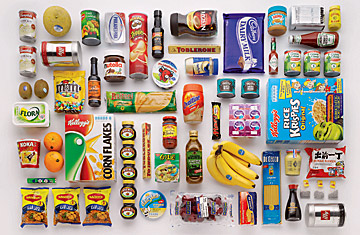
(2 of 2)
The great restaurants, with their low-carb dishes that take a paragraph to explain on a menu, prepare food that is too complicated for most people to prepare at home. It is also too expensive. Most of the great cities of the world, once refuges for the poor, are increasingly enclaves for the wealthy where cooks and even farmers can experiment without considering cost. New York City has established a much loved system of neighborhood "farmers' markets." Originally a movement to take control back from corporate industrial agriculture, these markets, serviced by local farmers trucking in their goods, are a most fascinating collusion of small-scale farming and wealthy consumers. There is almost no limit to the price such farmers can ask for their produce. Farmers traditionally like to grow crops as large as possible because the ratio of weight to effort is better. People like baby vegetables because they are cute—tiny carrots, peanut-like squash and bean-sized brussels sprouts. If the customer pays enough, the farmer will pick the vegetable when it's tiny. Precious small radish-sized potatoes from white to purple, and very waxy to very floury, sell in New York City for a price per size comparable to Manhattan real estate. The wealthy, of course, reject industrial farming, which was always intended to mass produce for the poor (and yet has failed in its greatest goal: to end world hunger). To see just how much resistance to industrial agriculture there is among the rich, travel to rural areas where wealthy urbanites have their vacation homes and watch them pay fees for the privilege of stooping in the field to harvest a crop.
Because it's assumed that the rich eat better, the media focus on the people who cook for them. The result has been the transformation of the working-class cook, servant to the rich, into the luminary chef. Those with the luxury not to hunger for food hunger for celebrities—the royalty of our age. But the three-star restaurants are not the ones charting the course of food. History has shown that food almost always impacts culture from the poor up, not from the rich down. The creativity of great French chefs belies the fact that there is less and less cooking going on in the average French home, almost none of it in any way resembling the food of restaurants; that it is becoming increasingly difficult to find good bread in France because few want to be a baker, a hard and low-paying job; that more rarefied crafts like chocolate making are difficult to continue because adolescents now go to school instead of apprenticing; and that industrial farming continues to squeeze out small, quality producers.
And yet, industrial food is out of fashion. Today there is a global market for organic fruits and vegetables, free-range birds, oysters from microbeds. Technology is in. Genetically modified food offers many opportunities, not the least of which is crops that are so insect repellent they need no pesticides. But—to the fury of some farmers—some of the same people who reject pesticides and call for organic food are now calling for a ban on genetically modified food. The argument, though a bit murky, is powerful. While there is no solid proof of the evils of such food, why trust hi-tech food from the same corporations that brought us industrial food?
Climate change is also changing our food, particularly through its impact on that great supplier, the ocean. Water is becoming not only warmer but less salty. The oceans, however, have been assaulted with not only climate change, but with pollution and destructive industrial fishing. Many predictions about seafood stocks are dire. Will most of them be seriously depleted by the year 2048, as one marine biologist recently predicted? Has the number of large fish in the ocean decreased by 90% over the past 50 years, as another scientist reported? Are 31% of the 274 commercially important fish stocks in America overfished, as a 2002 U.S. government report asserted? Are 60% of the fish species studied by the U.N. Food and Agriculture Organization (FAO) either fully exploited or depleted, as an FAO report claims? What is clear is that popular fish such as Atlantic salmon, cod and tuna are vanishing. We are now eating varieties that 40 years ago were considered "trash fish." On the coast of Cornwall, in England, monkfish is the largest catch in ports that used to be known for sardines, herring and cod. But what happens if the monkfish start to vanish too? The only certainty is that the survival of the ocean's fish can no longer be assumed—something that portends not just a crisis for biology, but one of the most dramatic shifts in food consumption ever seen.
History carries tremendous burdens—the age of empire, the Industrial Revolution—that influence our lives and what we eat today. To understand the food of today, the past must be remembered. For the same reason, if future historians want to look back at what life was like in the early 21st century—the technological and information revolutions, the blessings and dangers of globalization, the challenges to the survival of a healthy planet—they would do well to look at our food. Changes in food have always been a function of changes in society. We are—and will always be—what we eat.